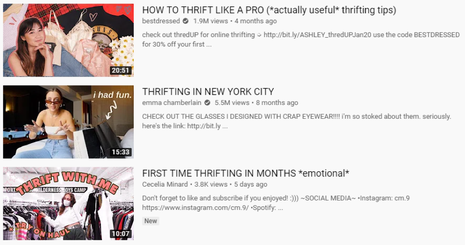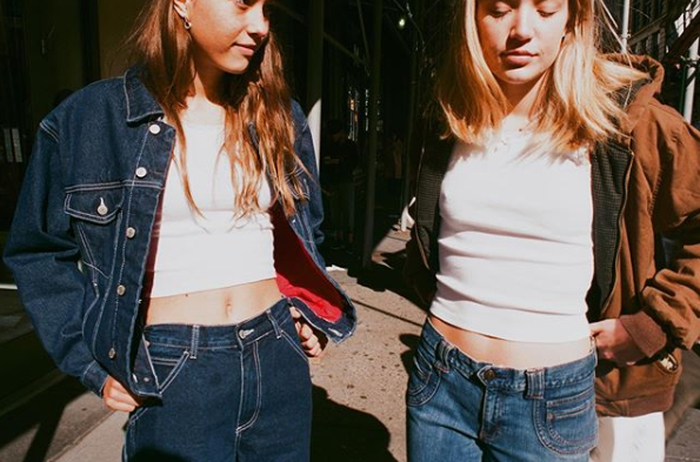Second-Hand Clothing, First-Hand Fashion?
Depop, ThredUp, Urban Outfitters – Erin Gerrity takes a look at how past fashion is replacing fast fashion and what consequences this rising popularity has on the accessibility of the second-hand industry.
As trends cycle back into fashion, you might often feel yourself regretting binning that neon tank top worn by your thirteen-year-old self, or wishing your mum had kept her well-worn bell bottoms. If you didn’t foresee the fashion trends of this decade, you might choose to turn to the rising second-hand clothing industry, as others have done already: the ThredUp 2019 Resale Report predicts that the second-hand apparel market will double within the next five years, due to steady growth in thrifting and exponential increases in the incidence of resale.
Much of this growth can be attributed to the new breed of YouTubers dedicating their channel to affordable thrifted clothing hauls. You can find hours and hours of content showing the creators searching to find styles that have cycled back into fashion for a fraction of the price at which you could buy them brand new.
The online encouragement to purchase on-trend items from second-hand retailers slowly diverts customers away from fast fashion brands, which offer comparable prices but at a monumental environmental cost – the accepted trade-off for low production costs. This has resulted in the fashion industry becoming one of the world’s biggest polluters, second only to oil, producing 5% of global CO2 emissions.

Many fast fashion companies have capitalised on the rising trend of thrifted clothing by producing items that appear thrifted, such as ‘vintage’ American baseball sweatshirts or ‘reworked’ cropped polo shirts. Take Urban Outfitters (UO) as an example: their retro, ‘thrifted’ style shapes their brand image, both aesthetically and ethically. A report by Good On You evalutes the environmental impact of UO, stating that although they stock a small line of vintage and upcycled products (Urban Renewal), the company uses very few eco-friendly materials even in their main collections.
Thrifting and other second-hand shopping certainly acts as a considerable force in our movement towards sustainability
Although the increased popularity of thrifting has removed much of the taboo surrounding second-hand apparel, it is important to remember that a large number of people have no alternative and shop in thrift stores out of financial necessity. Some may argue that ‘privileged’ individuals should not shop second-hand because they are reducing the number of quality items available for those that can’t afford anything else. For example, larger sizes are just as rare in thrift stores as they are in high-street stores and the trend of converted larger-sized items into over-sized pieces in the name of fashion is adding to this issue.
It has also been reported that stores are raising their prices to capitalise on the rising demand partially triggered by the ‘Come Thrift With Me’ vloggers, making the apparel less affordable for low-income shoppers. This is most common in cities like London or LA. Whilst in an ideal world this arguably unethical behaviour would not occur, our only ability to counteract this trend lies in avoiding the stores that unjustly raise their prices.
The other arm of the second-hand apparel industry is resale, which has experienced a revolution following the introduction of social media sites. Depop, founded in 2011, now has around 13 million users and a sales figure that is doubling year on year. Competitors include Vinted, Poshmark and ThredUp, as well as an increasing presence of sellers on platforms like Instagram. Despite the relatively premium prices of items on these apps compared to those you could find thrifting yourself, their popularity is unprecedented. This is likely due to the convenience of scrolling through second-hand items from the comfort of your bed whilst someone else spends their weekends trawling through mounds of clothing at thrift stores.
As one might expect, there is a generational divide in the expanding online resale market, but also in the second-hand industry as a whole, partly due to the fact that it meets the two contrasting desires of Generation Z (aged 18-24): wearing the latest fashion trends and shopping sustainably. The percentage of Gen Z that shopped second-hand in 2019 soared above that of older generations.
Is it reasonable for these customers to shop second-hand for the sake of staying on-trend, potentially reducing what is available for those that can’t afford more? Or perhaps the environmentally-conscious ‘privileged’ customer should be buying exclusively from the increasingly-prevalent sustainable and ethical brands, which are on average more expensive than the two alternatives: fast fashion and thrifting.
On the other hand, let us take the example of Tala – an activewear brand founded by recent Oxford graduate, fitness influencer and entrepreneur Grace Beverley. Tala markets itself as sustainable, high-performance and on-trend, whilst matching the prices of non-sustainable competitor brands. If Tala can do it, why can’t all companies follow suit?
Ethical brands are becoming more and more affordable, so what is the excuse for not buying their clothes if you’re in the financial position to do so? Some people may say that it is their right in a free market economy to purchase goods and services at a price controlled by the open market and by consumers, which includes low-priced fast fashion. However, an increasing proportion of people argue that those in the financial position to do so should exclusively buy from ethical brands like Tala, for the sake of our planet.
Sustainability is becoming a more prominent theme in the fashion industry, but is still threatened by the power of fast fashion. Will the popularity of thrifting and resale apps persist? Will social pressure result in an industry-wide takeover by ethical brands? Ultimately, we don’t know what the future will hold, but thrifting and other second-hand shopping certainly acts as a considerable force in our movement towards sustainability.
 News / News in Brief: Postgrad accom, prestigious prizes, and public support for policies11 January 2026
News / News in Brief: Postgrad accom, prestigious prizes, and public support for policies11 January 2026 Comment / Will the town and gown divide ever truly be resolved?12 January 2026
Comment / Will the town and gown divide ever truly be resolved?12 January 2026 Features / How sweet is the en-suite deal?13 January 2026
Features / How sweet is the en-suite deal?13 January 2026 News / 20 vet organisations sign letter backing Cam vet course13 January 2026
News / 20 vet organisations sign letter backing Cam vet course13 January 2026 Comment / Plastic pubs: the problem with Cambridge alehouses 5 January 2026
Comment / Plastic pubs: the problem with Cambridge alehouses 5 January 2026










